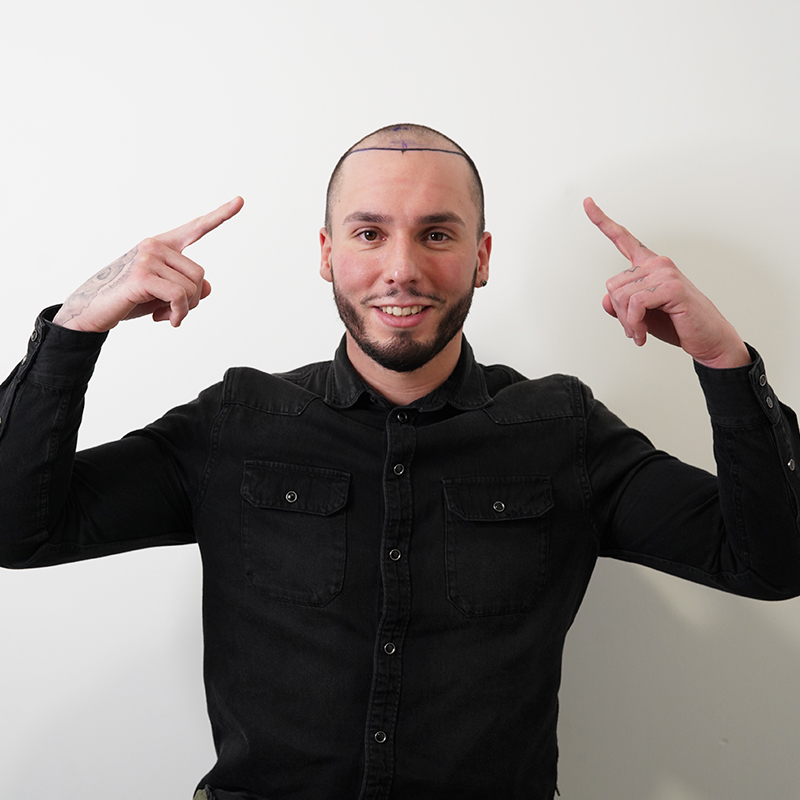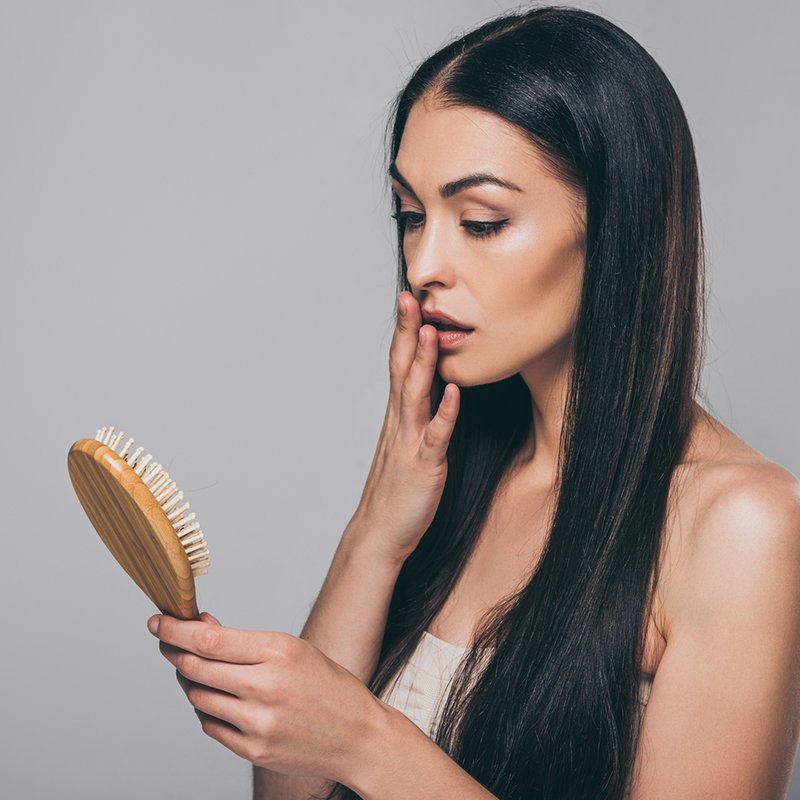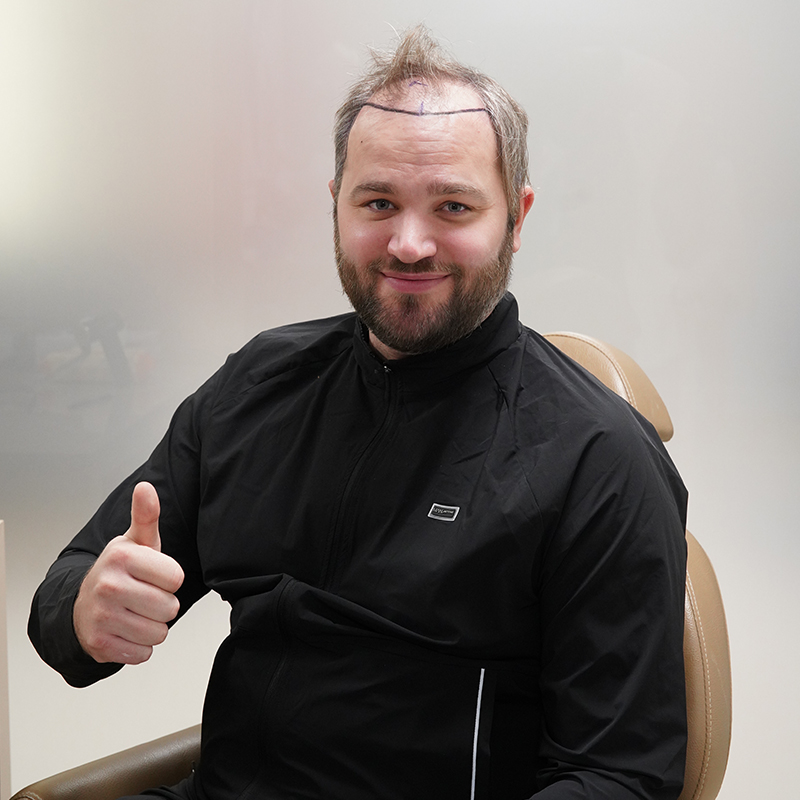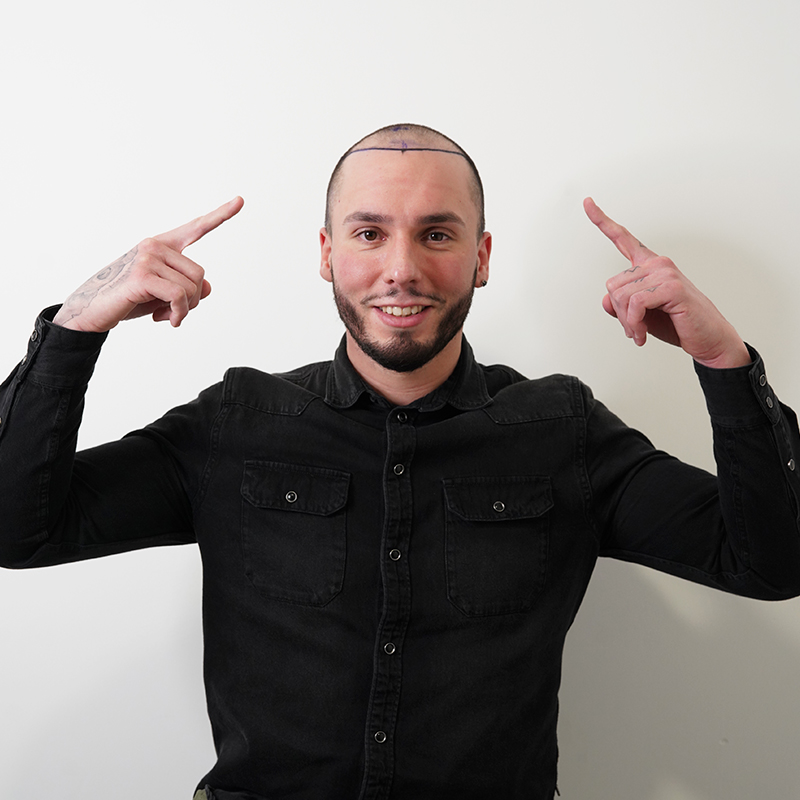Everything About Hair Loss
Growing almost everywhere on the human skin, hair is composed of a tough protein called keratin which is created out of hair follicles. Scientists believe that the average human head has about 100,000 to 150,000 hair, and each day, about 100 strings of hair are shed, so a little bit of hair on your comb shouldn’t make you panicked.
About 90% of human hair keeps growing throughout our lives, and each follicle has its own life cycle which is dependent on factors such as age and diseases. This life cycle is generally categorized into three stages: in the anagen phase, hair growth actively proceeds for about two to eight years; the catagen phase keeps hair growth at a transitional period that lasts two to three weeks; and lastly, the hair growth enters into a resting stage for about two to three months. Eventually, the hair is lost and replaced by a new strand of hair; then the cycle begins again.
Hair growth rate is unique to each individual, but an average growth rate of 1 cm per month is a commonly seen progress rate. Naturally, age brings a decrease to this growth and causes to the death of melanin-producing pigment cells. As a result, a head full of gray hair…

Symptoms of hair loss
The symptoms of hair loss, which are mostly quite subtle, have a tendency of appearing gradually, so developing signs of hair loss, millions of people around the world do not even notice the hair loss condition for months or years.
Appearing in many ways, the symptoms of hair loss may include:
- Gradual thinning hair on the scalp
- Bald spot that expands slowly
- Receding hairline that becomes more visible as time passes
- A widening part
- A horseshoe-shaped pattern that exposes the crown of the head
- Thinning ponytail
It is important to note that in some cases, the hair loss can occur suddenly, therefore it is possible to notice a bald spot appearing within 1 or 2 days, clumps of hair shedding when you brush your hair, or most of the hair on your scalp suddenly falling out.
While it is usually the scalp which is the affected area, it is possible that the hair aside from the head starts to shed. Some conditions, such as alopecia create, can cause hair loss occurring anywhere on the body; partial hair loss on the eyebrows, eyelashes, beard, nose and pubic hair is a commonly seen sign of alopecia aerate.
In some cases, people might lose all the hair on their body, and the diagnosis changes into the condition called alopecia Universalis.
And then there is frontal fibrosing alopecia in which the hair loss occurs not only on the scalp but also anywhere of the body, such as eyebrows or eyelashes.
Other symptoms of hair loss
Depending of what causing the hair loss, some people develop different symptoms aside from the above-mentioned. These signs may include:
- Burning or stinging: alopecia areata can cause this.
- Intense itching and burning on the affected area: the possibility of an infection.
- Flaking on the bald patches with blisters leaking pus is often a sign of a fungal infection.
- Swelling, and itching sores: may be a result of folliculitis decalvans
- Psoriasis patches on the scalp: the condition called psoriasis can cause temporary hair loss.
How to classify hair loss
Categorization of hair loss can be carried out in several ways by a professional. Firstly, your doctor examines the scalp to see whether the hair loss stems from a physical issue or damage on the hair follicles. If there are lots of empty hair follicles on the scalp and no visible problems, it is a sign of non-scarring hair loss. But destruction of hair follicles can result in permanent hair loss, and this is called cicatricial alopecia.
Patchy hair loss
Originating from a variety of conditions, there can be small or large patched areas on the scalp that sheds its hair. Common triggers of patchy hair loss include:
- alopecia areata (small circular shaped bald patches on the scalp growing back within months),
- traction alopecia (thinning and shedding from tight braids, buns or ponytails),
- trichotillomania (a mental disorder characterized by the urge of hair-pulling),
- tinea capitis (fungal infection),
- secondary syphilis.
Diffuse hair loss
Diffuse hair loss, which appears as an overall thinning without visible bald patches, is likely to occur in the presence of following conditions:
- pattern alopecia,
- drug-induced alopecia,
- protein malnutrition,
- systemic disease-induced alopecia (cancer, endocrine disease, and telogen effluvium)
- telogen effluvium (shedding after delivery, or sudden weight loss etc.)
- androgenetic or androgenic hair loss (male-pattern baldness and female-pattern baldness).
How is hair loss diagnosed?
Hair loss is a common complaint that can be seen frequently in both women and men and could be an indicator of many underlying disorders. It can occur anywhere on the body, butthe biggest problem for patients with aesthetic concerns is hair loss on the scalp. The cause of hair loss in man easily diagnosed in cases like male pattern hair loss or patchy hair loss; however, this diagnosis period can be highly challenging and should not be underestimated. Before deciding on a diagnosis, your doctor will likely examine your medical and family history and carry out a physical exam.
Medical history
In order to determine the cause of hair loss, your doctor will likely to ask a variety of questions about your medical history: how long has it been since your hair loss began, what kind of patterns do you have, whether hair loss is hereditary, and other characteristics about your symptoms.
Physical Exam
Examining your scalp thoroughly checking for inflammation or scarring, your doctor will try to determine how much hair you are losing, your hair loss pattern, and the state of hair breakages.
During your physical exam, your doctor may regard a number of simple tests as necessary and perform them to learn more about your hair health. These tests may include following:
Pull Test and Tug Test
The pull test is used for measuring the severity of hair loss. It is a really simple procedure: your doctor grasps few strands of hair – about 40 – from various sections of your scalp and slowly pulls. The number of falling hair determines whether you have hair loss or not; if it is more than six strands, then your hair is actively shedding.
When doing a tug test, your doctor holds a few strands of hair and tugs them to specify if there is a breakage, pulling from both sides of the hair. Once the tug test completed, your doctor will be able to analyze the fragility of your hair.
Card Test
The card test is used for determining the number of hair strands that are still growing. The white side of this card contrasts with dark-colored hairs, and with the black side, light-colored hairs become easily visible against the card.
The results of the card test can be especially helpful for identifying the symptoms of various conditions such as thinning hair or hair shaft abnormalities.
Fungal Culture
A fungal culture is a laboratory test that can reveal if there is a fungus in the hair or on the scalp. Your dermatologist may recommend this test to see whether your hair loss originates from a fungal infection such as tinea capitis or scalp ringworm.
While sampling for laboratory testing takes a relatively short amount of time, the overall process may require a few weeks of incubation in laboratory.
Punch Biopsy
Although a physical examination is usually enough in order for your dermatologist to determine the cause of your hair loss, if your doctor decides to do further examinations so as to improve the diagnostic process, he/she might execute a scalp biopsy.
A punch biopsy is a diagnostic test where a small, tube-shaped piece of skin tissue is removed using a device that has the size and shape of a pencil. Typically used to distinguish between the types of cicatricial or scarring alopecia, this sample is sent to a laboratory, and the incision is easily closed with a few stitches.
Blood Tests
Contrary to common belief, hair loss on the scalp is not always hereditary, so as a precaution to an underlying medical condition such as a vitamin deficiency or a hormonal imbalance, your doctor may recommend various blood tests.
What causes hair loss?
Hair loss is typically associated with one or more of the following circumstances:
Androgenetic alopecia / Genetic factors
Androgenetic (or pattern) alopecia is a genetically determined condition characterized by the gradual shrinking of hair follicles until the growth completely stops. As the most common cause of hair loss worldwide, androgenetic alopecia is also known as male/female pattern baldness, and both men and women usually struggle with this type of hair loss at some point of their life.
Androgenetic alopecia is more likely to occur later in life, but it is still possible for the hair to start to shed as early as adolescence. While hereditary hair loss in women tends to occur as overall thinning, the primary sign of baldness in men is a receding hairline or hair loss on the crown of the head. Moreover, hair loss in men has a tendency of progressing faster on a wider area.
Telogen effluvium
Telogen effluvium is probably the second most common form of hair loss. It is typically characterized by diffuse thinning of hair, and as long as there is no underlying pattern alopecia condition, recovery spontaneously begins within 6 months.
Disturbances to the hair cycle are the primary cause of telogen effluvium. If the number of hair follicles generating hair decreases for any reason in the midst of the resting or telogen stage, the hair follicles at telogen phase begins to increase considerably, and thus, the telogen effluvium occurs.
Although it may be limited to either one or more areas, telogen effluvium emerges as thinning of the hair on the head, usually more shedding on the top of the scalp as compared to the sides and the back.
Telogen effluvium can be caused by a number of triggers, including severe stress, surgery, pregnancy, sudden weight loss, menopause, poor diet, certain drugs and medical conditions. Even though a fair amount of hair loss could be terrifying, you don’t need to worry; because this type of hair loss is almost always temporary that resolves over time.
Anagen effluvium
Anagen effluvium is a form of nonscarring, often referred to as chemotherapy-induced alopecia. Just as the telogen effluvium, in this condition too, disturbances of the hair follicle cycle are the primary sources.
When there is an interruption to the anagen phase of the hair by means of a toxic or inflammatory agent, the hair shaft is affected, and visible hair shedding occurs dramatically. It is possible to suffer from complete loss of hair on the scalp, including eyebrows, eyelashes and body hair. Anagen effluvium is commonly characterized as an outcome of the head or neck radiotherapy, chemotherapeutic factors such as antimetabolites and alkylating agents, toxin exposure, and infections. These elements can disturb or completely cease the anagen cycle and cause severe follicle damage. Considering the fact that almost 80-90% of the hairs are in the anagen phase, an extensive part of the scalp is affected.
Usually within the 14 days of execution of the drugs in question, hair shedding occurs; however, most of the time, it is reversible, and hair is recovered almost immediately after the elimination of the underlying agent.
Alopecia areata
Alopecia areata is a form of hair loss identified with shedding in small, non-scarring alopecia patches, appearing as regional impairment. While it could be unnoticeable at the initial stages, the affected areas can merge, becoming more visible. Alopecia areata generally occurs on the scalp, but it is important to note that any of the bodily hair is prone to shed in patches.
This complex disease has lots of contributing factors, but it is regarded as an autoimmune disease since it is a result of white blood cells attacking healthy hair follicle cells. They start to shrink, and eventually hair production comes to an end. The amount of shed hair is unique to each individual; some lose in a few spots, and for some, it is more severe. Although it is quite rare, alopecia areata can cause complete hair loss on the scalp (alopecia areata totalis), or the entire body (alopecia areata Universalis). It is usually reversible, hair grows back within 6-12 months, yet it is common for the condition to recur.
In this condition, it is not known specifically what triggers the immune system to attack the healthy hair follicles; it could be a kind of a virus or bacteria, environmental elements could have a role, or both of these factors could contribute to the initiation.
Some scientists suspect that hereditary factors may be involved, particularly when the condition occurs under age 30, as one in five people with the alopecia areata has at least one close family member who has been diagnosed with the same disease.
Traction alopecia
Traction alopecia is a type of hair loss that is the result of systematic tension on the scalp hair follicles. Hair being pulled back tightly, whether in braids, buns or tight ponytail, damages follicles, resulting in thinning and hair loss, and in some cases redness, scaling, itching and even infections.
Early symptoms of traction alopecia may involve little bumps that seem like pimples. As time passes, hair breakage occurs, and thinning becomes observable, especially at the temples and the front part of the scalp. When traction alopecia forms, not all the scalp hair but the ones pulled back is usually affected.
In the early stages, traction alopecia is not regarded as scarring, but repeated and consistent tension on the hair may become a threatening risk factor, and destruction of hair follicles eventually cause a transition to permanent alopecia.
The treatment and prevention of traction alopecia depend on the severity of the condition and the possibility of permanent alopecia. In case of early intervention, it is quite possible to reverse the hair loss by eliminating the strain-causing factors, or else surgical methods could become the only feasible options to regrow the hair. Hence, it is extremely critical to changing the hairstyle every now and then, avoiding tight braids, wearing extensions for short periods of time, and staying away from hair-damaging chemicals that make them more prone to breaking.
Medical conditions
A variety of medical conditions can result in hair loss, whether inactive disease period or in recovering phase, making the progress much more stressful than it is. Although there are so many medical conditions that cause hair shedding, some of the most common issues include the following:
- Lupus: This is an autoimmune disease that brings about a vast number of symptoms affecting hair and skin. Lupus triggers the autoimmune system to attack healthy cells, and in addition to severe fatigue and joint pain, damage to hair follicles result in hair loss. Hair becomes brittle and sheds in patches. There might be short, broken hairs above the forehead. The shedding may appear on the beard, eyelashes or eyebrows, but as it is a result of an underlying condition, it is usually not permanent.
- Thyroid issues: Both an overactive thyroid (hyperthyroidism) and an underactive thyroid (hypothyroidism) can become a contributing factor to rapid hair loss. When the thyroid gland does not produce enough hormones, hair loss may occur as a symptom, along with weight issues, depression and fatigue. However, it is typically reversible with proper medication treatment.
- Cancer: While hair loss is usually regarded as a side effect of chemotherapy used for cancer treatment, certain types of cancer – such as rarely seen Hodgkin’s lymphoma – can cause thinning or shedding of the hair.
- Trichotillomania: This is a mental disorder that triggers an irresistible urge to pull out hair from the scalp, eyebrows etc. The person with trichotillomania experiences unbearable tension, and pulling hair provides a satisfactory feeling. Emotional stress, anxiety, changes in hormonal balance and obsessive-compulsive disorders are involved in the occurrence of trichotillomania.
- Eating disorders: Disorders such as anorexia and bulimia can cause severe hair loss, including thinning and bald spots. When the body is deprived of necessary nutrients providing healthy hair growth, it starts to use up the protein stores so as to protect vital bodily functions. Considering the fact that hair is not a vital component of the body, hair growth comes to an end.
- Polycystic ovarian syndrome: Women have naturally androgens in their bodies, and some of the hair follicles are connected to them. If you struggle with polycystic ovarian syndrome, the levels of androgens in your body may increase over time, and if your hair follicles have a sensitivity to androgens, then hair thinning might occur.
- Diseases such as muscular dystrophy, pituitary gland issues, sarcoidosis, late-stage syphilis or HIV hair transplant can also cause various types of hair shedding.
- Radiation therapy
Radiation therapy is used for destroying cancerous cells, but it also damages the healthy parts of the body. Considering the fact that the cells which are most prone to damage are the ones that grow at a fast rate, it is quite reasonable to struggle with hair issues during radiation therapy process.
Radiation therapy typically causes hair loss to the treated area. The dose of the radiation and the size of the affected part generally determine the amount of shed hair. Sometimes, there can be hair loss on the spots where the radiotherapy beams pass through. A treated person may lose some of his/her hair, resulting in a thinner look, but it is quite common to experience total hair loss. Generally, hair loss starts 2 to 3 weeks after the treatment initiated, and the hair grows back naturally when the treatment is over, though not always as thick as it used to be.
Chemotherapy drugs also can lead to excessive hair loss, affecting not only a limited area but all the hair on the body. So, you should carefully consider the fact that you will experience a dramatic bodily hair loss. It will typically start 2 to 3 weeks after the treatment begins.
Nutritional deficiencies
Nutrients such as vitamins and minerals are vital components of healthy cell growth, so it is quite possible that vitamin and mineral deficiencies may cause various types of hair loss. Before taking an action and resorting to easily accessible supplements, you should get information on which vitamins and minerals have relation with hair loss. And it is important to note that unless you are actually deficient in some key nutrients, your body will only get rid of the excessive vitamin intake.
Iron deficiency is the most common nutritional deficiency in the world and is a famous contributor to hair loss. If the iron deficiency turns into anaemia, then the hair loss becomes much more visible. Stimulating the hair follicles, vitamin D is also critical to hair health; in fact, it is suspected that vitamin D might be a cause of alopecia areata. Minerals such as biotin, zinc, niacin, selenium and folic acid have also an effect on hair loss conditions and overall hair health.
Medications
Hair loss is a common side effect of a vast number of medications. Generally, the medication in question interferes with the cycle of hair follicles, and consequently, stops the hair growth at various phases of the hair cycle, depending on the nature of the medication. Examples of these include:
- amphetamines
- angiotensin-converting enzyme (ACE) inhibitors
- antidepressants, including paroxetine (Paxil), fluoxetine (Prozac), and sertraline (Zoloft)
- antifungal medications
- antiseizure medications
- beta-blockers used to treat heart problems and glaucoma
- birth control pills
- blood thinners, including heparin and warfarin
- chemotherapy
- cholesterol-lowering drugs, such as clofibrate (Atromid-S) and gemfibrozil (Lopid)
- drugs for the treatment of thyroid problems
- famotidine (Pepcid)
- hormone replacement therapy (HRT)
- isotretinoin (Accutane) and other vitamin A-based medications
- levodopa (Atamet) and other medications for Parkinson’s disease
- naproxen (Naprosyn) and other nonsteroidal anti-inflammatory drugs (NSAIDs)
- steroids
- Pregnancy
During pregnancy, a majority of the scalp hair goes into the growth phase, and the hair looks full and healthy more than ever. Unfortunately, once the delivery happens, the estrogen levels start to decrease, hairs go into the resting phase, and then rapid hair loss starts.
This type of hair loss is usually temporary, it does not create permanent bald spots. Typically, within 3 to 4 months, the scalp goes back into the normal follicle cycle and regains most of the hair that was shed. For the purpose of slowing down the shedding process, pregnant women should use biotin-including shampoos and conditioners, avoid hairstyles that can strain the hair, adopt a diet high in fruits and vegetables, and keep away from excessively heated hair tools.
Ringworm
Resulting in hair loss, ringworm is a skin condition caused by a fungus that lives on the dead tissues of skin, hair and nails. The early symptom of ringworm on the scalp is usually a small sore or a bump. As the condition progresses, the bump becomes flaky and scaly, and sensitive to touch. Moreover, the affected areas may start to shed hair in patches. At this stage, an antifungal medicine or antibiotic may become necessary, so it is advisable to get examined by a professional and ask for a prescription.
Burns, injuries, x-rays
Hair loss may occur in case of a burn or an injury; x-rays can also cause temporary hair loss. As long as any kind of scarring is not present, there won’t be permanent damage, and the hair will be back to its normal state once the injury heals.
Cosmetic routines
Cosmetic procedures, such as perms, bleaching and hair dying can be counted as a contributing factor to the overall hair thinning because they weaken the hair and make them brittle. Likewise, tight braids, buns and ponytails can damage the hair; using rollers and hair curlers are also involved in thinning hair condition. But it is important to note that the hair loss resulted from these procedures is not permanent and does not cause baldness. The only thing you should do is stepping in and eliminating the source of hair loss. After that, your hair will begin to regrow.
Risk factors
There are a number of factors that contribute to the rise of the hair loss risk, including:
- Genetic predisposition for balding,
- Changes in the weight balance
- Excessive stress
- Certain medical conditions, such as lupus and thyroid issues
- Increase in male hormones
- Ageing
How to prevent hair loss
Although natural balding can not be reversed, there are several precautions that could protect hair from further damage, including:
- Going natural, avoiding dyeing and bleaching
- Using a basic shampoo and conditioner designed for your hair type
- Washing the hair only every other day, unless you have excessive oil in your hair
- Avoiding rubbing the hair
- Staying away from tight hairstyles such as ponytails, buns or braids that put too much strain on the hair
- Limiting the use of styling products, especially heated ones such as blow dryers, hair straighteners, heated combs etc.
- Adopting a nutritious and balanced diet that includes healthy fats, proteins, certain vitamins and minerals
- Reducing stress and anxiety by making lifestyle changes

 FR
FR ES
ES IT
IT DE
DE RU
RU PT
PT AR
AR RO
RO BG
BG MK
MK IL
IL GR
GR ID
ID SK
SK JP
JP CN
CN PL
PL KR
KR


